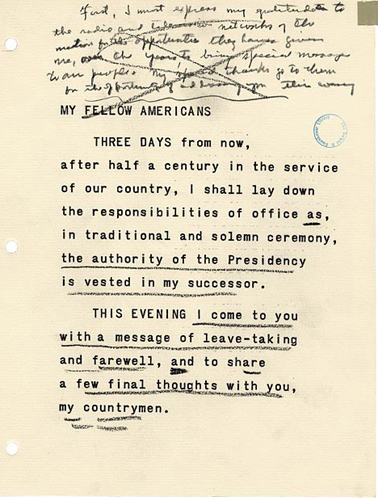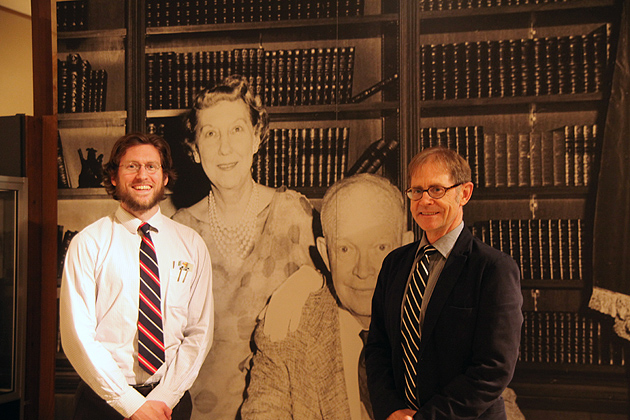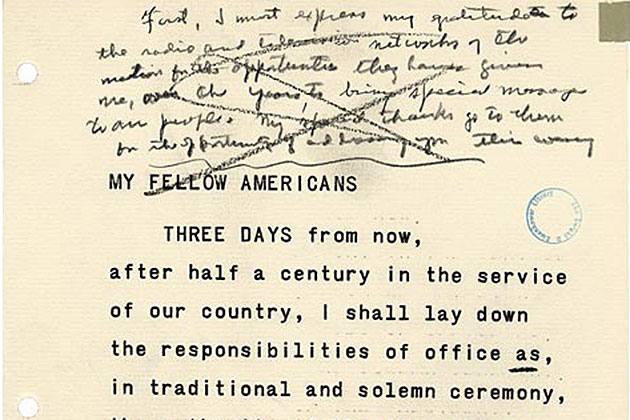
Genetic analysis has led to a variety of important scientific advances from improving disease diagnosis, to developing more effective drugs, to the emergence of gene therapy.
But can it help us get inside Pres. Dwight D. Eisenhower’s head?
UConn alum Michael Wininger ’03 (CLAS) believes it absolutely can.
Eager to share his concept, Wininger, an expert in analytical science and bioinformatics, recently presented his theory to an audience of archivists and other interested parties at the Dwight D. Eisenhower Presidential Library & Museum in Abilene, Kan. His presentation was titled: “Ike & The Draft: What molecular biology can tell us about Eisenhower’s Farewell Address.”
The key to Wininger’s approach lies in identifying patterns of words and phrases in a document – in this case Eisenhower’s famous speech regarding the rise of the military-industrial complex – and comparing them as they change and move within different drafts. He sees these kernels of composition as something akin to “genes of thought” – those core messages that define a piece of writing similar to the way a set of genetic markers defines a human being.
But unlike the detection of compositional themes found naturally in writing, Wininger’s process drills deeper, tracking individual words and phrases as they gain importance, lose their value, or are scrubbed entirely. He can check the evolution of a paragraph, a phrase, a word, even a single letter in a line of thought.
He says this sort of intense quantitative analysis provides historians a more thorough understanding of the writer’s creative process and the external and internal influences that may have impacted his or her perspective during construction of a speech or other literary work. It may also promote understanding of the fundamental cognitive process involved in putting thoughts on paper.

“I love taking things that are hard to see and making them visual,” says Wininger, currently an assistant professor of neuroscience and biomechanics at the University of Hartford.
Wininger graduated from UConn in 2003 with degrees in both mathematics and physics. He holds a Ph.D. in biomedical engineering from Rutgers University, and did postdoctoral work in bioinformatics at the Max Planck Institute for Informatics in Saarbrucken, Germany and the National Institutes of Health from 2009 to 2011. Along with his current teaching and research duties, Wininger continues to serve part-time as a statistician of medicine for the U.S. Department of Veteran Affairs’ VA hospital in West Haven, Conn.
“When I look into [Eisenhower’s Farewell Address], I want to know what Eisenhower really wants to communicate. What are the genes of his speech?” Wininger says. “It’s hard for me to read through the speech and say this is what he had in mind. But if you look at the genes, the eight or 10 pockets of speech he moved around, those are the keys to his speech.”
Wininger believes archivists and other researchers may find the identification of certain thought patterns in writings of interest, and that there is a whole field of literary and creative analysis that could benefit by using his scientific approach.
“Like what the Human Genome Project did with genes 20 years ago, this could be transformative if we could show archivists and historians that there are analytical tools out there for them to use, tools that they may have no idea exist,” he says.
“Through the Human Genome Project, we have come to learn many new things about various diseases such as breast cancer,” he notes. “By applying the same analysis to archived documents, we could potentially uncover untold fortunes about our history – why we went to war, why war was prevented, why Eisenhower did this, why Truman did that, what Lincoln was thinking ….”
Tim Rives, deputy director of the Eisenhower Presidential Library, found Wininger’s approach interesting.
“I think it’s an innovative and exciting way to look at the records we hold at the Eisenhower Presidential Library,” says Rives. “Dr. Wininger has discovered a new way to discern meaning and information from historical documents. We look forward to seeing the results of his continuing research.”
Wininger chose Eisenhower’s Farewell Address not only because of its important context in history, but also because 21 versions of the speech exist in archives. So far, he has only examined a handful of drafts, but he definitely found some key elements that carried through the writing process, indicating that these were the important messages the 34th president wanted to convey.
Once you quantify the abstract, it becomes portable and anyone can analyze it any way they want.
In comparing drafts, Wininger would place the contents of one draft along the vertical axis of a graph and the contents of another draft along the horizontal axis and then scan the two drafts for matches that could be represented in a matrix. It’s the same technique used in analyzing sequenced DNA, where thousands of genes in individual chromosomes are compared and matches in the genetic code are found and analyzed.
The size of the computation was impressive. Comparing one draft of 11,200 characters or letters with another draft containing 11,587 characters resulted in 130 million data points in the matrix, Wininger said. Yet out of that volume, individual clusters of data representing particular words or phrases could be identified, allowing him to see how Eisenhower re-worded sentences and moved thoughts around for maximum impact or clarity.
For instance, in a draft of the speech prepared on Jan. 7, 1961, Eisenhower wrote: “Leadership and prestige depend, not merely upon our astonishing material progress or our massive military strength – unmatched as these are – but also on how we use moral and material power in the interests of world peace and human progress.”
Ten days later in a subsequent draft, Eisenhower reworked the section to read this way: “Understandably proud of this pre-eminence, we yet realize that America’s leadership and prestige depend, not merely on our unmatched material progress, riches, and military strength, but on how we use our power in the interests of world peace and human betterment.”
Wininger says his analysis also helped the museum clarify when an undated draft of the Farewell Address was produced, by comparing its composition to earlier and later versions of the speech.
Wininger is hesitant to interpret his findings. He only knows what he sees.
“I am neither a historian nor a psychologist, so it goes well beyond me to figure out why certain things may have changed in a draft,” he says. “But I think the answer to that ‘why’ is out there, and I would love to be able to refine the question so the folks who can answer why would have a why to explain.”
Wininger says he is not interested in profiting from the concept. For him, this is entirely a scholarly endeavor. He is currently drafting a paper explaining the application, and intends to make the tool publicly available free of charge to anyone who wants to use it, once the appropriate software is configured.
The analysis software could have other broad applications, Wininger says, from rooting out plagiarism to helping scholars learn more about drafts of the Declaration of Independence, U.S. Constitution, and even non-historical documents such as two drafts of a popular book or an undergraduate essay.
“It’s really difficult to quantify something so abstract, and if you can’t quantify it, it doesn’t avail itself to simple analysis or comparative analysis,” says Wininger. “Once you quantify the abstract, it becomes portable and anyone can analyze it any way they want.”



